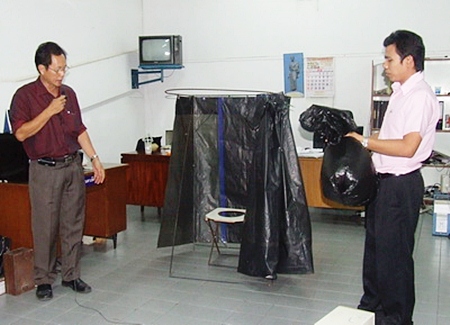Thailand has seen several months of devastating floods, the biggest in the past 50 years. The megaflood has claimed more than 400 lives and caused tremendous damage to farms and property. While millions in the north and central plains are struggling to live with harsher living conditions, some have come up with brilliant ideas to live with the water.
Although both public and private sectors are tirelessly helping flood victims, it might not be enough only to wait for assistance from others. We must be prepared to help ourselves.

In order to fight the flood crisis and to protect ourselves from such situations, some in already flooded areas have been trying to protect their homes or workplaces by all means possible, using conventional wisdom, while others started inventing new solutions, coming up with do-it-yourself (DIY) approaches to facing the floodwaters or helping other people.
A toilet is a necessary convenience for we human beings. A folding portable toilet has been developed by the Faculty of Engineering at the Prince of Songkla University in the south.

One mobile toilet comprises a folding seat, made of a thick wooden board, and a curtain part using plastic to hook with a steel frame. The curtain can be adapted for use as a mobile shower if a water tank is connected.
In addition to the toilet, an automatic sandbag loading machine was created as practical quick fix flood response by the Engineering Faculty of Rajamangala University of Technology Thanyaburi.
Working a full capacity the machine only needs two people to load wet or dry sand in 7-14 sandbags in just one minute, resulting in 420 to 840 sandbags per hour. It can convey sand at the rate of 60-140 kg/minute. The machine is controlled by a one horsepower engine, and also has a built-in mobile electric generator.

Meanwhile, an item to save lives when the water level is high is a life vest or a buoyancy aid. A good life jacket will help its wearer float in the water with his or her mouth and nose above water even when losing consciousness.
Plastic bottles have been collected and used as rafts, or recycled into life-saving jackets.
According to the Mirror Foundation, which makes such vests to help flood victims, life jackets made from big plastic bottles can carry a weight of about 80kg, while bottles of medium size can carry about 60kg.

Other do-it-yourself items include the Disease Control Department’s ultimate life bags, which are similar to school bags and can support about 100kg. Suranaree University of Technology has flat-bottomed boats made from steel rods, canvas and plywood at a cost of Bt2,000 ($66), and Wangsapung Industrial and Community College has the IDEA Cover Car, made of 100% water-proof plastic which is durable to stay in water for 3 months.
In time of crisis, it is touching and gratifying when human beings help each other, but it is always better to be able to help yourself and try your best not to solely depend on others’ help.




